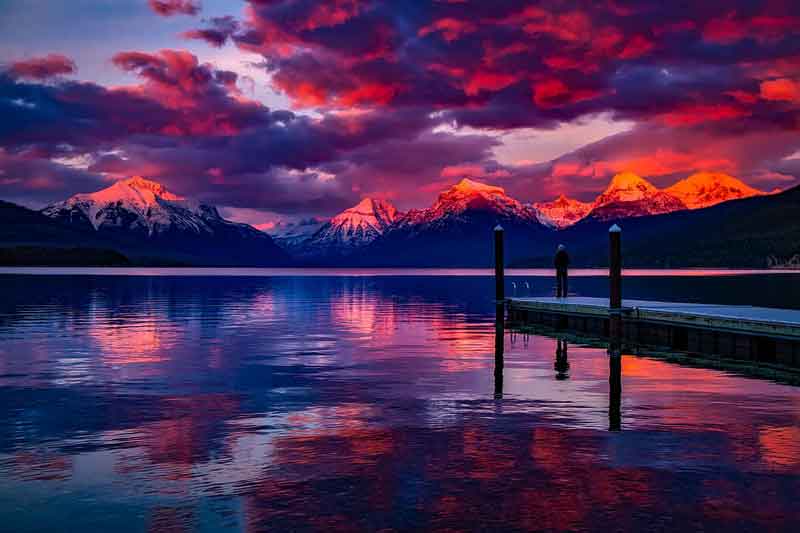
Montana definitely is not Manhattan.
Me: Living in this little Oxfordshire village is not giving you enough stimulation. You should move to London. Think of how much easier it would be to go to the theater and to art galleries.
Her: No, no. I am very happy here. In London, I would need to have a smaller place, whereas here I have my garden.
Me: But soon the garden will be too much work for you. Some of my elderly friends in the United States opted to retire to New York precisely because they didn't need so much space. And it's in the nature of a big city that you get to see more people.
Her: I don't want to see more people.
She won the argument, needless to say — and thank G od she did. I wake up at night in a cold sweat, imagining where we would be now if (for the first time in her life) she had given in to me and moved to London shortly after that conversation. For nothing could have illustrated with more shocking clarity the perils of big city life — especially for someone in her 80s — than the coronavirus pandemic.
For anyone past the age of retirement, 2020 has been the year of the village. Cities have been risky — the excess mortality rates from COVID-19 are higher for London than for England, much higher for Madrid than Spain, and vastly higher for New York than for the United States.
As for old folk's homes, in many cases they have been lethal. The great Austrian economist Friedrich Hayek turns out to have been right when he predicted, in "The Constitution of Liberty," in 1960, that "concentration camps for the aged unable to maintain themselves are likely to be the fate of an old generation whose income is entirely dependent on coercing the young." Some long-term care facilities have been more like death camps. Those who have long worried about the unfunded liabilities of welfare states and defined-benefit pension plans will one day surreptitiously raise a glass to COVID-19 and "care" facilities.
There are myriad reasons why COVID-19 has hit some countries harder than others, including the crucial yet poorly understood role of social networks in spreading the disease. (These vary quite a bit in their structure from place to place.) But it seems fairly clear that the presence in some countries of a few supersized cities is part of the story.
Take New York. Between March 11 and May 9, excess mortality relative to the seasonal average — the best measure of the pandemic's impact, since the counting of COVID-19 cases is not consistent across countries — has been 266 percent (24,200 more deaths than usual at this time of year). That is one of the highest excess death rates I have seen anywhere. The figure for the United States as a whole is just 19 percent.
This illustrates a key theme in the British physicist Geoffrey West's brilliant 2017 book "Scale: The Universal Laws of Growth, Innovation, Sustainability, and the Pace of Life in Organisms, Cities, Economies, and Companies." West reveals the remarkable law that "if a city is twice the size of another city in the same country . . . then its wages, wealth, number of patents, AIDS cases, violent crime, and educational institutions all increase by . . . about 15 pecent above mere doubling." As West puts it, "A person may move to a bigger city drawn by more innovation, a greater sense of ‘action,' and higher wages, but she can also expect to confront an equivalent increase in the prevalence of crime and disease."
The bigger the city in relative terms, the more pronounced the effect. Paris is six-and-a-half times larger than France's second city, Lyon; London four times larger than Manchester; Moscow three times larger than St. Petersburg. In each case, the impact of COVID-19 is likely to be greater than the difference in size would imply. Just as it is no virus for old men, SARS-CoV-2 is most at home in a megalopolis.
So does this mean that Parisians will now flock to the half-empty ghost villages of la France profonde? Will the many posh Londoners currently working from their second homes in the country never return? The answer is that, over a five-year time period, the effect will be less than you might predict today. The big cities of the world have survived much worse than this. Just read Daniel Defoe's "Journal of the Plague Year" (1722) if you think London can't bounce back from a bout of pestilence. London survived even the Nazi plague known as the Blitz.
Still, the big cities are going to be rather dismal places for the next couple of years. I could imagine as many as 70 percent of New York restaurants never coming back: Margins were already tight, and a 50 percent reduction in the number of covers to allow for social distancing spells death. The grim reaper will seem to ride in every crowded subway car and elevator.
So, dear mother, you were right. Stay right where you are in your village. And I — who once hypocritically sang the praises of the bright lights and the big city — will remain here in Montana, where social distancing is a way of life and grizzly bears are a bigger threat than that nasty little bug from bug city.
(COMMENT, BELOW)
Niall Ferguson's latest book is "The Square and the Tower: Networks and Power from the Freemasons to Facebook."
(Buy it at a 58% discount by clicking here or order in KINDLE edition at a 47% discount by clicking here). He is the Milbank Family Senior Fellow at the Hoover Institution, Stanford University, and a senior fellow of the Center for European Studies, Harvard, where he served for twelve years as the Laurence A. Tisch Professor of History.


 Contact The Editor
Contact The Editor
 Articles By This Author
Articles By This Author